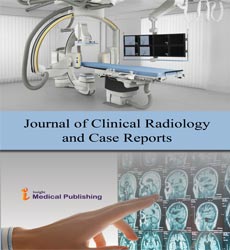Thorax : Visualization of Chest Radiographs from Helical CT .
Rie Tanaka*
Department of Radiological Technology, Kanazawa University, Japan
- *Corresponding Author:
- Rie Tanaka
Department of Radiological Technology, Kanazawa University, Japan
Tel: +81344507634
E-mail: rie44@mhs.mp.kanazawa-u.ac.jp
Received Date: July 23, 2021; Accepted Date: October 11, 2021; Published Date: October 21, 2021
Citation: Tanaka R (2021) Thorax: Visualization of Chest Radiographs From Helical CT, J Clin Radiol Case Rep Vol: 5 No: 4.
Abstract
Chest imaging is an important tool in the management of critically ill patients. The simple chest x-ray is still used to quickly spot abnormalities in the chest. This article provides basic information on interpreting chest x-rays that will enable the reader to review relevant anatomy and physiology, summarize normal values and abnormal findings on chest x-rays, and describe x-ray findings for common heart and lung diseases.
Keywords
Chest x-ray; Flat panel detector (FPD); Detection of pulmonary nodules
Introduction
View of chest x-rays taken as an additional examination in chest radiography. Helical (spiral) computed tomography (CT) has a dramatic impact on body imaging as a patient Many of these artifacts are associated with the accentuation of vascular or parenchymal enhancement. Others arise in the production of high quality 3D images. With increasing experience with the Helix-CT, further artifacts will certainly be identified. Factors unique to Helix technology can lead to artifacts that need to be considered when interpreting helix-generated scans. Dynamic chest radiography can be used as a simple and fast means of functional imaging in routine and emergency medicine.
Methods
Chest images are best interpreted using a systematic approach.In the case of uncomplicated upper respiratory tract infections or asthma, minor trauma, or acute and non-chronic chest pain, a radiological examination is not justified.
The conventional-CT is very sensitive in detecting pulmonary nodules, but false negative interpretations occur, mostly due to variations in depth of breath excursion, partial volume averages, or motion artifacts. They are located in the lower lobes of the lungs and on the periphery of the lungs, and it is in these locations that nodules up to 20 mm in size can be missed on conventional C T .
Between inspiration and expiration there can be a movement of up to 8 cm in the diaphragm; By reducing the breathing movement while holding the breath, the detection and characterization of pulmonary nodules is significantly improved.
Several studies have shown the higher precision of Helix CT compared to conventional CT for detecting pulmonary nodules. In the largest series comparing Helix CT and conventional CT with incremental 10 mm reconstructions, 42 additional nodules were detected by Helix CT. a greater number of nodules less than 10 mm in size and more nodules per patient were detected with spiral CT. Surprisingly, in conventional CT, respiratory artifacts were observed in 10% of the patients and required repeated CT sections, while none occurred in the same patients examined with Helix CT.
Helical CT shows a mass in the right lung that contains fat (white arrows) and calcification (black arrow). Helical acquisition with 4 mm collimation and 4 mm/s table feed with 2 mm incremental reconstructions provides precise densitometric measurements.
Flat Panel Detectors
FPDs are used in direct digital radiography (DDR) to convert Xrays into light (indirect conversion) or charge (direct conversion), which is read with a thin film transistor array (TFT)
Conclusion
The Helical CT shows small lung nodules that cannot be seen in conventional CT by eliminating errors in breath recording and comprehensively analyzing a coherent volume of data. Lung lesions can be analyzed in detail with the retrospective reconstruction of the data volume. and arteriovenous malformations are free of movement artifacts. Target paths are clearly shown by Helix CT, a skill that improves radiographic assessment of patients with hemoptysis, bronchial stenosis, tumors, and recent lung transplantation, with shorter uptake time. Clinical applications include the detection of central pulmonary thromboembolism and the evaluation of aortic aneurysms and dissections.
Open Access Journals
- Aquaculture & Veterinary Science
- Chemistry & Chemical Sciences
- Clinical Sciences
- Engineering
- General Science
- Genetics & Molecular Biology
- Health Care & Nursing
- Immunology & Microbiology
- Materials Science
- Mathematics & Physics
- Medical Sciences
- Neurology & Psychiatry
- Oncology & Cancer Science
- Pharmaceutical Sciences
